New York
About Andrew Cusack
 Writer, web designer, etc.; born in New York; educated in Argentina, Scotland, and South Africa; now based in London.
Writer, web designer, etc.; born in New York; educated in Argentina, Scotland, and South Africa; now based in London. read more
News
Blogs
Reviews & Periodicals
Arts & Design
World
France
Mitteleuropa
Knickerbockers
Argentina
The Levant
Africa
Cape of Good Hope
Netherlands
Scandinavia
Québec
India
Muscovy
Germany
Academica
Back in the Day
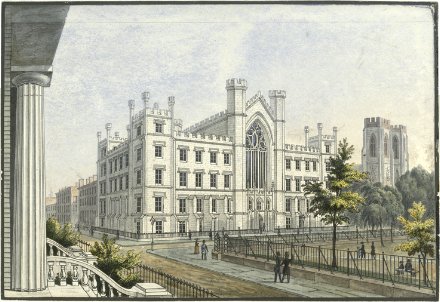
The University of the City of New York (now New York University),
Washington Square, 1850.
Public Elitism
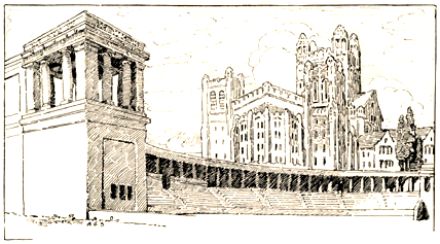
The Manhattan Institute‘s splendid City Journal of Spring 1999 carried an article worth a read entitled ‘How Gotham’s Elite High Schools Escaped the Leveller’s Ax’ on the few quality public schools left in the City of New York and how they managed to stem the tide of egalitarian senselessness.
Egalitarianism is one of the most morally repugnant of all ‘Englightenment’ ideas. To look upon success, label it “unfair” or “racist”, and then demand that, as a sacrifice to the false-goddess Equality, all must fail. It is the typical socialist formula that it is better that all wallow in poverty rather than only some (or even many but not all) succeed.
So a number of these high schools have survived. It is perhaps even more of a shame that none of the colleges did. City College was once known as “the poor man’s Columbia”. The quality of education at both City College and Columbia fell as a result of the cultural revolution of the 1960’s and 70’s. Columbia, for the most part free from the fetters of state intervention, never hit rock bottom and in many ways remains a quality institution, despite the highly politicized and racialized nature of many of its students and faculty. City College, however, went into freefall. Admission was thrust open to anyone who had graduated from a New York public high school, which coincided with the lowering of graduation requirements by these high schools. Thus you had students who could barely read and almost certainly could not write attending an institution which prided itself on its many Nobel laureates.
It is testament to the levelling zeal of the angry left that not even one college, not even one, within the entire City University of New York was allowed to maintain high standards of academic achievement. They will tear down with savage avarice the highest ideals of civilization to quench their destructive thirst. And these are colleges which for decades had been the ticket to freedom and success for hundreds and thousands of economically-disadvantaged New Yorkers. (Imagine if they had gotten their hands on the independent places of learning!). No wonder there are so many stupid people in New York these days.
But at least the high schools are still there, and calls for their emasculation are now few and far between. True, they are not ideal, but can we realistically expect a government-tethered school to be as such? Of course not. We should be glad that there remain at least a handful of public academies of high standards in New York available to all – rich, poor, and anywhere in between – based purely on merit.
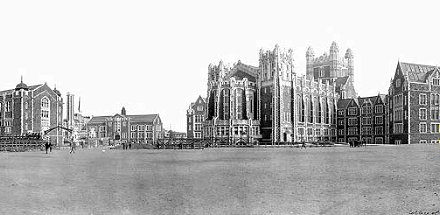
St. Vincent Ferrer
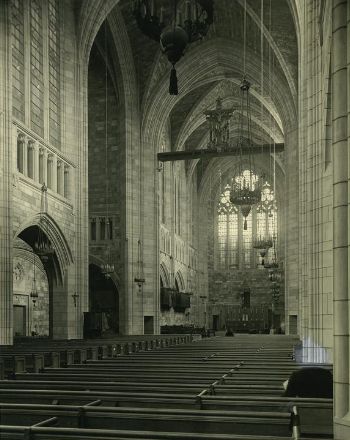
This photo shows the interior of the Dominican Church of St. Vincent Ferrer, designed by Goodhue, before it was fully completed. The stained glass has yet to be installed, and the same goes for the giant reredos which now graces the altar. A more current view is below.
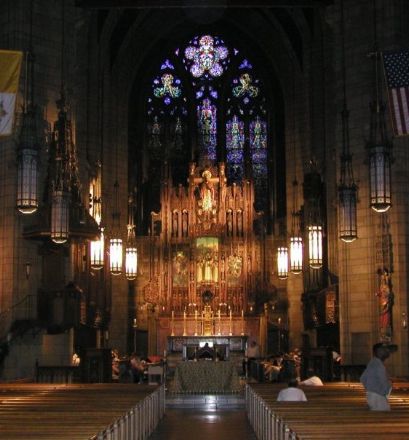
The Goodwin Mansion II
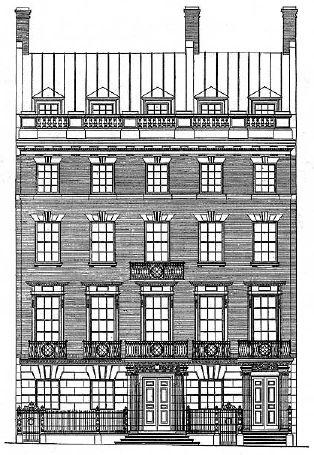
As an appendix to my previous post on the Goodwin mansion, I bring you an elevation of the facade (above) and the original plan of three of its floors (below).

The Colonial Colleges
| NAME |
LOCATION | FOND. | CHART. | DENOM. |
| Harvard College (Harvard University) |
Province of Massachusetts Bay |
1636 | 1650 | Puritan |
| College of William and Mary |
Colony and Dominion of Virginia |
1693 | 1693 | Anglican |
| King William’s School (St. John’s College) |
Province of Maryland |
1696 | 1784 | Non-denominational |
| Yale College (Yale University) |
Connecticut Colony |
1701 | 1701 | Congregationalist |
| Moravian College |
Province of Pennsylvania |
1742 | 1863 | Moravian |
| Newark Academy (Univ. of Delaware) |
Delaware Colony |
1743 | 1833 | Non-sectarian |
| College of New Jersey (Princeton University) |
Province of New Jersey | 1746 | 1746 | Presbyterian |
| Augusta Academy (Washington and Lee University) |
Colony and Dominion of Virginia |
1749 | 1782 | Non-sectarian |
| Public Academy of Philadelphia (Univ. of Pennsylvania) |
Province of Pennsylvania |
1749 | 1755 | Non-sectarian |
| King’s College (See below) |
Province of New York | 1754 | 1754 | Anglican |
| Rhode Island College (Brown University) |
Colony of Rhode Island and Providence Plantations |
1764 | 1764 | Baptist |
| Queen’s College (Rutgers University) |
Province of New Jersey | 1766 | 1766 | Dutch Reformed |
| Dartmouth College | Province of New Hampshire | 1769 | 1769 | Congregationalist |
| College of Charleston | Province of South Carolina | 1770 | 1785 | Non-sectarian |
| Salem College | Province of North Carolina | 1772 | 1866 | Moravian |
| Hampden-Sydney College | Colony and Dominion of Virginia | 1775 | 1783 | Presb. |
Note One: “Non-denom.” should be interpreted as Christian but not of a denominational nature. “Non-sectarian” should be interpreted as secular and having little or nothing to do with religion.
Note Two: King’s College in New York has two successor institutions: King’s College in Halifax, Nova Scotia, and Columbia University in New York, New York. The largest portion of the faculty of King’s College in New York fled north and in 1789 refounded the college in Windsor, Nova Scotia. However, the original buildings of King’s College were usurped by a new institution called Columbia College four years earlier in 1784.
King’s College formerly counted its foundation from 1754, while Columbia used the 1784 date. However, this has since switched and Columbia now proudly (though perhaps dubiously) claims 1754 as its foundation while King’s College more safely uses 1789.
Perhaps both institutions have a shared right to the founding date, as the loyal alumni continued their allegiance to King’s in Nova Scotia while the rebellious graduates considered Columbia the rightful heir. As stated, Nova Scotia had more of the people from the original foundation, whereas New York had little more than the physical building and a few of the graduates. I would be inclined to award 1754 to King’s College and 1784 to Columbia, (but then I’m biased against Columbia for being such a fallen institution).
Canon Bernard Iddings Bell
Warden of St. Stephen’s College in the Hudson Valley of New York
As for what the Church thinks and says, what influence does that have on the handling of American politics, the conduct of American education, the regulation of marriage and divorce, on sex and drink, on how industrial disputes are settled, on how we carry on business?
As a plain matter of fact, religion in this country is generally regarded as a tolerated pastime for such people as happen to like to indulge in occasional godly exercises — as a strictly private matter in an increasingly close-knit and socially acting society — in other words, as something that does not count.
I should like to see the Church recognize that it has been pushed into the realm of the non-essentials, and to persuade it to fight like fury for the right and the duty to bring every act of America and Americans before the bar of God’s judgment.
[Christian leaders] are making valiant claim to such a right and duty; but the great mass of Church members are content to regard the Church as a conglomerate of private culture clubs, nice for christenings, weddings and funerals. Most Church members readily agree with the unchurched majority that it is not the proper business of the Church to criticize America or Americans.
— Canon Bernard Iddings Bell
The 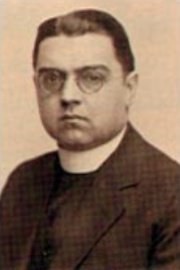 Rev. Canon Bernard Iddings Bell and seems to have been something all too rare in the history of America: a wise and presient Episcopalian cleric (which is not to say we have had any more than a mere handful of wise and presient Catholic clerics in this land).
Rev. Canon Bernard Iddings Bell and seems to have been something all too rare in the history of America: a wise and presient Episcopalian cleric (which is not to say we have had any more than a mere handful of wise and presient Catholic clerics in this land).
Bell served as Warden of St. Stephen’s College – situated on the Hudson River here in New York – from 1919 to 1933, and is widely considered responsible for turning it into what was one of the best collegiate institutions in the country. In 1928, under Bell’s tenure, St. Stephen’s became a college of Columbia University, and this period of the College’s history was highly praised by the great Russell Kirk.
Kirk, in Decadence and Renewal in the Higher Learning, after positing his view of the ideal undergraduate college as a place of classical and liberal learning, takes note of St. Stephen’s. “There have been such colleges in this country,” Kirk wrote. “One such was St. Stephen’s College… when Dr. Bernard Iddings Bell was president. (He told me once that he gave up the presidency when strong objection was raised to his rule that the students should dress decently and rise when professors entered a room.)”
Of course, such arcadian days did not last. Only a year after Bell gave up the wardenship of St. Stephen’s in 1933, the college changed its name from honoring Saint Stephen, the first Christian martyr, to the more secular Bard College honoring the founder of the institution, John Bard.
A mere ten years later in 1944, Bard College became coeducational and as such severed its relationship with Columbia University, becoming independent as a secular, nonsectarian liberal arts college ‘affiliated’ with the Episcopal Church. The once-great college has now declined to such an extent that a professorship there is now named in honor of Alger Hiss, the man who betrayed America to spy for Soviet Russia. Sic transit gloria mundi.
Kirk relates another anecdote of Dr. Bell:
Canon Bernard Iddings Bell once showed a visitor from England about the environs of Chicago. They drove past a handsome Gothic building of stone. “Is that a school?” inquired the visitor.
“Yes– a new one, ‘distressed’ to appear old,” Dr. Bell replied.
“Indeed! Who is the headmaster?”
“There is no headmaster.”
“Curious! A kind of soviet of teachers, I suppose.”
“There are no masters at all.”
“Really? Do the boys teach one another?”
“As yet, there are no students. Here in the United States, we proceed educationally in a way to which you are unaccustomed,” Canon Bell told his friend. “First we erect a building; then we obtain pupils; next we recruit teachers’ then we find a headmaster; and at last we determine what is to be taught. You begin at the other end in England.”
Again, a quote from Canon Bell:
We need to forget the imaginary Christ who has been ours too long and to rediscover the real Christ, the Christ of the prophets and the martyrs and the confessors, the Christ who is not only the lover of souls but also master, a monarch with demands to make in industry, in finance, in education, in the arts, in marriage, in the home; the Christ who is teacher of a social ideology which has eternal validity; the Christ who cries aloud with convincing force, ‘He who would save his life will lose it; only he who is willing to lose his life, can find it.’
Rowing in Pelham Bay
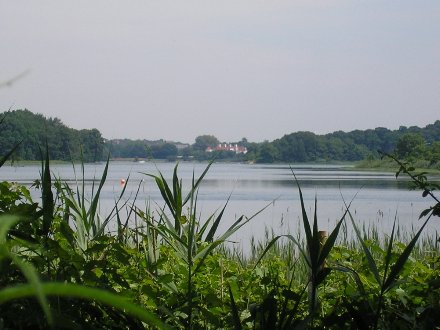
During the past fortnight, I have been learning to row on the lagoon in Pelham Bay Park, a body of water with which I had no previous aquaintance. “Learning to row?” you ask. “But weren’t you in the University of St Andrews Boat Club during your bejant year?” Yes, dear reader, I was a full paid-up member of said body, but I was too busy avoiding lectures, failing courses, and other such frivolities of one’s first year at university to actually row, and only went to circuit training when Ezra Pierce irritated me enough that I felt obliged to give in and head on over. Nonetheless, at the suggestion of a good friend I decided to enroll in this program and have not regretted it at all. Rowing, in short, is addictive, and it is a grand shame that I shall have to wait until at least September in Scotland to get back on the water. (Above, the Travers Island clubhouse of the A.C. can be seen from the far end of the lagoon). (more…)
The Carbuncle Responds
Well our favorite Jewess-turned-evangelical-turning-Catholic, Miss Dawn Eden, picked up on the complaints yours truly had about the Brooklyn Museum in her weekly Daily News column (scroll down, “A Boil Grows in Brooklyn”, NY Daily News, July 10, 2005). Well folks, someone at the B.M. must’ve been reading because later in the week upon collecting our mail I received an envelope from none other than the Brooklyn Museum itself.
The contents? Four free guest passes and a brief missive:

I laughed out loud when I read it. I’m glad they have a sense of humor, though it doesn’t make up for the new entrance. Nonetheless, I shall take them up on their offer. Perhaps the carbuncle is not quite as grievous in the flesh. Perhaps it’s worse. It remains to be seen.
The last time I went to Brooklyn (so far as I can remember) was to Fort Hamilton, one of the few remaining military installations in the city, back in 2000. It was Independence Day and my uncle was leading the artillery battery firing the salutes at the incoming tall ships for OpSail 2000.
Risen from the Ashes
by Austin Ruse
Sursum Corda, Summer 1998
The first wholly traditional Catholic parish structure built since Vatican II could not be situated in a more central location, at a more opportune time. New York is enjoying an astounding 1990s rejuvenation, bulging with tourists and new business. St. Agnes Church is at the center of it all, in midtown Manhattan, near Grand Central Station.
 Only at St. Agnes in New York City can an orthodox churchman be attacked from the right. Yet there they were, a dedicated band of angry young people picketing Msgr. Eugene V. Clark at Mass only one week after St. Agnes had burned nearly to the ground in late 1992. Their charge? That the good Monsignor intended to replace the old brick Gothic structure, now ruined, with what they called a “Swedish-Igloo-Modern.” Monsignor Clark never gets mad, but he got mad that day – although today he looks back on the incident with amusement. He even saved one of their flyers and is considering having it framed.
Only at St. Agnes in New York City can an orthodox churchman be attacked from the right. Yet there they were, a dedicated band of angry young people picketing Msgr. Eugene V. Clark at Mass only one week after St. Agnes had burned nearly to the ground in late 1992. Their charge? That the good Monsignor intended to replace the old brick Gothic structure, now ruined, with what they called a “Swedish-Igloo-Modern.” Monsignor Clark never gets mad, but he got mad that day – although today he looks back on the incident with amusement. He even saved one of their flyers and is considering having it framed.
Did those excitable young men and women actually live within the parish boundaries of St. Agnes? No. But then hardly anybody actually lives in the East 40s. St. Agnes has maybe 100 to 150 residential parishioners. Nobody really cares, either; and this is one of the charms of St. Agnes. It is a commuter church located next to one of the busiest ports of call in the world, Grand Central Station. St. Agnes Church is a place that is searched out, discovered, chosen. To many it seems that St. Agnes chooses them.
But there was that awful day when many thought it might close. (more…)
The Vicious Carbuncle of Brooklyn
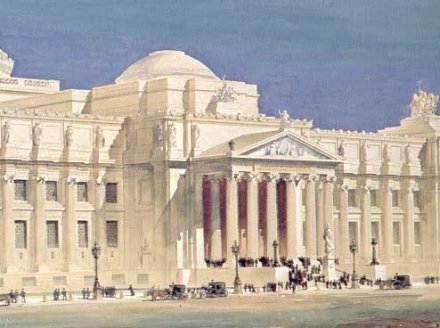
The Brooklyn Museum ought to be ashamed of itself. Though frequently overshadowed by its civic compatriot, the world-class Metropolitan Museum of Art in Central Park, this institution in Brooklyn’s Prospect Park is still considered one of the best museums in the United States. Its overall design was the work of the renowned McKim, Mead, and White who planned a sprawling beaux-arts palace for what was then known as the Brooklyn Insitute of Arts and Sciences. Their own illustration of the final design can be seen above and below (click the below image for a larger version). (more…)
Shenorock
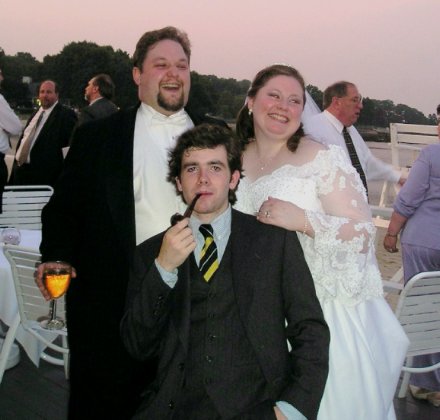
The more deductively inclined amongst you, dear readers, shall of course have extrapolated two conclusions from the above photograph. First, there has been a wedding. Second, I have obtained a pipe. Huzzahs all around.
I have known the young lady formerly known as Katie Lennon as long as I can remember, and I’ve known Brendan Daly more or less as long as they’ve been an item. The twain were joined in a happy and blessed union on Saturday afternoon at the Church of St. Joseph in Bronxville, and we all wish Mr. and Mrs. Brendan Daly a fruitful and happy marriage. The reception followed shortly afterwards at the Shenorock Shore Club on Milton Point in Rye, New York.
I had not really been to Shenorock in a number of years but many a day in the Cusack childhood was spent there, especially during the summers. We kids generally found it disagreeable while our parents found it an ideal place to unwind. Some summers my mother worked the 7:00pm to 7:00am shift at Lawrence Hospital in Bronxville. She would come home from work in the morning, wake my brother, sister, and I, pile us into the car, pick up the Lennon children and the McKegney children and head to Shenorock. We were kept busy at the club’s day camp while Mum slept on the beach for a five or six hours, read when awake, then collected us all again, dropped us off at our homes, fed us Cusacks dinner, and headed off to work.
For some reason I never liked going to Shenorock as a kid but nonetheless the place is a fountain of fond memories as I grow older. Just the other day a few of us were sitting in Scott Bennett’s back garden; Scott and I reminisced about summers at Shenorock, kickaboo juice, and crazy Mr. A (the summer camp’s director). Tommy Lennon (who’s my age, the younger brother to Mrs. Daly) and I would built forts and castles on the beach and man them with those little green plastic army men. Barbecues in the wooded Bowery were frequent, and of course the magnificent fireworks display for the Fourth of July was an annual obligation (who can forget the grand finale!). Strangely, we kids also had a pronounced hatred for Coveleigh, the neighboring club. (For some reason there was no similar disliking of the American Yacht Club, also on Milton Point on the other side of Shenorock). They were the France to our Germany and for some reason amongst us young’ins the rivalry was passionate. Of course now that I’m an old man Coveleigh’s bowling green grows more and more attractive.
Shenorock’s home on Milton Point is easily the most beautiful spot on the Westchester coast (only Red Bridge and Manor Park come close to challenging it). A seemingly permament breeze rolls off the Long Island Sound and keeps the Summer Clubhouse with its long, awninged deck overlooking the sandy strand at a comfortable temperature. The Winter Clubhouse across the street overlooks Milton Harbor and the dining room once afforded an excellent prospect of the Twin Towers all the way down in Manhattan. A happy place with happy memories.

The large beach in the center belongs to Shenorock, with the large summer clubhouse on it with flanking cabanas. The winter clubhouse and dock are on the other side of Milton Point, on Milton Harbor. Coveleigh is at the top right, and the American Yacht Club at the bottom left, covering the end of the point.
From Google Maps
And the pipe, dear reader? What a felicitous gift! It was a present from my old school friend Lev Trubkovich (aka Leviathan), who even chucked in some tobacco from Nat Sherman. The last time I had enjoyed the pleasures of the smoking pipe was deepest winter amongst our friends in New Haven. Places where we have smoked our pipe so far: on Red Bridge, watching the world (and the geese, and the swans) pass by; in my hammock in the back garden whilst reading; in Pelham enjoying the company of Nick Merrick, Panda, Simon (also called ‘Generalinnimo’ owing to his short stature), and Miss McGarry; and finally, planted in a deck chair at Shenorock on Saturday evening. We hope we shall find many more places to enjoy our pipe.
Calatrava’s St. John the Divine
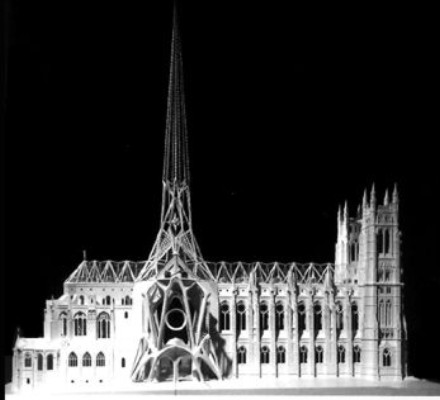
I’ve always somewhat admired Santiago Calatrava’s plan for the completion of the (Episcopalian) Cathedral of St. John the Divine here in New York. It was commissioned in the 1980’s by the über-dodgy Rev. James Parks Morton, dean of the Cathedral at the time. Morton was responsible for turning “St. John the Unfinished” into the hippie-trippy-ecumenical-syncretist-pagan-temple-cum-performing-arts-center it is known as today, and came up with this scheme to try to bring the cathedral to completion. (The plan has since been abandoned and all construction ceased a decade ago; scaffolding remains because the cost of removing it was judged to be too high).
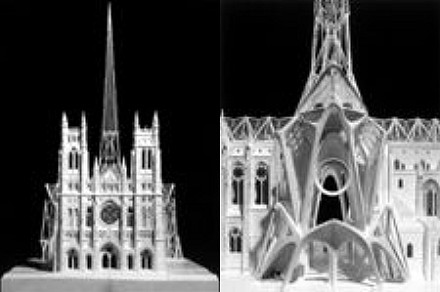
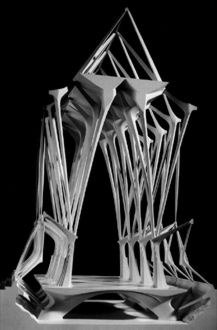 The plan involved a ‘biosphere’ garden being planted atop the nave in the giant greenhouse formed by Calatrava’s lithely arches. Though I much prefer the crossing tower in the design by Ralph Adams Cram, I still think that Calatrava’s plan is rather exciting. It only succeeds, however, because Cram and (Heins & Lafarge before him) laid an ample beautiful foundation (well, obviously quite much more than that) for Calatrava to complete. The cathedrals which Signor Calatrava has designed completely himself have been completey devoid of aesthetic appeal, as well as conceived outside of the millenia-long tradition of church architecture.
The plan involved a ‘biosphere’ garden being planted atop the nave in the giant greenhouse formed by Calatrava’s lithely arches. Though I much prefer the crossing tower in the design by Ralph Adams Cram, I still think that Calatrava’s plan is rather exciting. It only succeeds, however, because Cram and (Heins & Lafarge before him) laid an ample beautiful foundation (well, obviously quite much more than that) for Calatrava to complete. The cathedrals which Signor Calatrava has designed completely himself have been completey devoid of aesthetic appeal, as well as conceived outside of the millenia-long tradition of church architecture.
The (Catholic) Diocese of Oakland commissioned Calatrava to design their new ‘Cathedral of Christ the Light’ after the old seat was greatly damaged in an earthquake. Despite the vacuousness of the design (model below), Signor Calatrava proved to be outside the Diocese’s budget, and his second-rate design was shelved and replaced with a third-rate design of a vaguely similar ilk. The third-rate design is the one which will be built, though a first-rate proposal in the vernacular style natural to California has been drawn up by Mr. Domiane Forte. Methinks Signor Calatrava should stick to his catchy bridges.
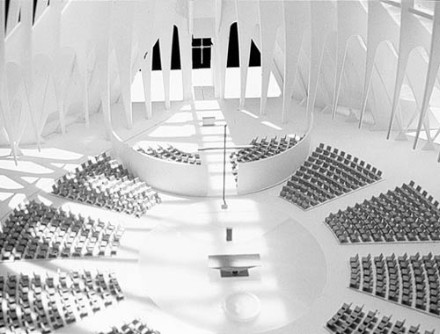
St. Gregory’s, Brooklyn
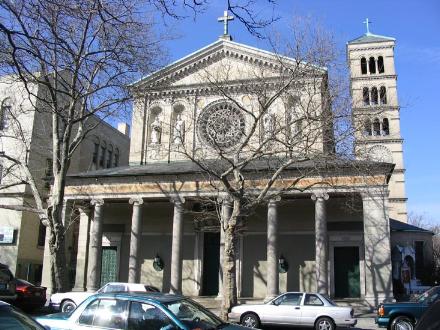
“St. Gregory’s Church of 1917, located at Brooklyn Avenue and St. John’s Place, was closely based on the ‘idealistic ground plan’ of St. Clement in Rome, an archetypal basilica with an open, colonnaded narthex and a tall engaged campanile on one side of the nave. In keeping with its prototype, St. Gregory’s was gaudily decorated with figural frescoes and mosaics.” – New York 1930
It seems a rather pulchritudinous church; I’ll have to add it to the list of places to visit. It was designed by Helmle and Corbett, who were also responsible for the Bush Tower, built a year later. The Bush Tower will soon get a brand new neighbor, seen below.

Top photo lifted from the ever-nifty Bridge and Tunnel Club‘s Walk Down Brooklyn Avenue.
Boldt Castle

Boldt Castle would have been among the finest homes in all New York had it ever been completed. The estate was started by Prussian immigrant and hotel entrepreneur George Boldt in the early 1900’s, and was intended to be presented to his wife Louise on St. Valentine’s Day. Tragically she died in 1904 before the castle was completed and work on the nearly-finished home stopped. The Boldts never returned to the island.
The small island estate is impressive nonetheless. It rests in the middle of the Saint Lawrence River on what was originally called Hemlock Island in the Thousand Islands region of New York. The island was renamed Hart Island when purchased by Congressman E.K. Hart, and upon being sold to the Boldts, the spelling was changed to Heart Island. (more…)
Rip van Winkle
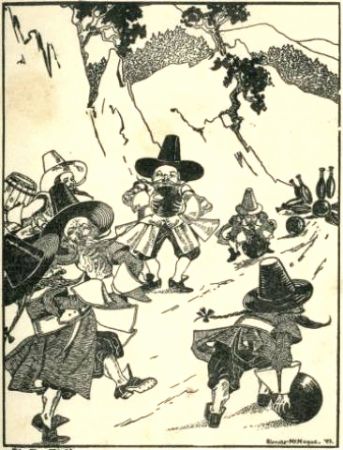
When was the last time you read the story of Rip van Winkle? If you’ve never had that pleasure, then you are all the worse for it, my friend. The tale was handed down to us through the ages by the munificence of one Diedrich Knickerbocker, though some sore-minded rapscallion later credited the ever-capable Washington Irving with its invention. Anyhow, it is one of my favorite tales in all the history of New York. It’s a short story, and worth a read online if you haven’t a printed copy immediately at hand.

The tale, of course, revolves around “a simple good-natured fellow”, namely Rip van Winkle, and his encounter with “odd-looking personages” whom still to this day show themselves around the Hudson valley. We merely have ceased to hear reports of them because thoroughly unimaginative types are in control of the world these days. (The “monotony monitors” as my Latin teacher monikered them, enforcing boredom and mediocrity at every possible opportunity).
The genealogists amongst you will be interested that Mr. Knickerbocker notes this van Winkle was “a descendant of the Van Winkles who figured so gallantly in the chivalrous days of Peter Stuyvesant, and accompanied him to the siege of Fort Christina.” Now, for want of fast-paced action, you may not have any particular desire to read about a simple, good-natured fellow like Rip van Winkle, but desires aside you must read “the Most Horrible Battle Ever Recorded in Poetry or Prose” (Chapter VII of Book VI of the same Diedrich Knickerbocker’s A history of New York, from the beginning of the world to the end of the Dutch Dynasty). The record of the siege of Swedish Fort Christina by the good New Netherlandish is the most hilarious and enchanting chronicle of any battle anywhere.
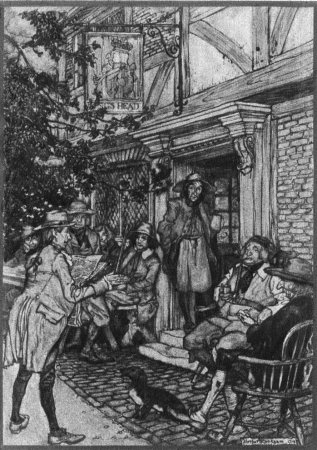
Home Again
A pleasantly uninteresting flight across the realm of the Atlantic and I am happy to find myself home in New York once more. Not much sooner had my parents and I returned to our little abode in Eastchester than we were off to dinner courtesy of Uncle Matt and Aunt Naomi (who live next door to us) at a happy little place called Joe’s on Marbledale Road in Tuckahoe — an eatery quite keen on what is most often called home food: simple, filling, and particularly appropriate in this circumstance. I then had my first legal drink in the States: Brooklyn IPA (India Pale Ale). Not a poor drink, but didn’t strike my fancy terribly. I have had better pints before, legal or not.
After we all returned to the Cusack family compound, I tried to convince my mother of the efficacy of Catholic social teaching for a bit before heading into town to Roger Mahon’s house, wherein lay Michelle Carroll and good ole Will Freeman. Mikey, the Mahons’ Irish Wolfhound, is pretty much fully grown now, but of a very kind nature. Caro Gill should’ve been there but was exhausted since it was her birthday.
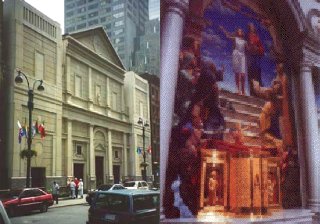
The Church of St. Agnes: exterior and tabernacle.
As I have often said, I always really know I’m home when I’ve heard the intoxicating incantation of the Asperges me at the 11:00 at St Agnes. The train from Bronxville is scheduled to arrive in Grand Central at 11:04 but almost always gets in two minutes before the hour, allowing just enough time to ascend to the grand concourse of that beaux-arts temple of transit, scurry through the Graybar passage, hop across Lexington Avenue to arrive at St Agnes just as the procession is finished and the Asperges commences. Today proceeded right on target.
Asperges me Domine hyssopo et mundabor,
lavabis me et super nivem dealbabor.
Misere mei, Deus, secundum magnam misericordiam tuam.
Gloria patri et filio et spiritui sancti,
erat in principio et nunc et semper et in saecula seculorum. Amen.
Asperges me Domine hyssopo et mundabor,
lavabis me et super nivem dealbabor.
The wonderful thing about the Latin mass at St Agnes is it’s always just as it should be. It’s not an over-the-top ostentatious drama as you might find at Anglo-catholic churches, nor a wailing maelstrom as at some charismatic churches, nor a banal mediocrity as at the average Marty Haugen parish. It is what it is, and it is beautiful and reflective of God’s eternal glory.
Taking the train back to Bronxville, on Metro-North’s brand spanking new rolling stock I might add, I noticed a number of new buildings which popped up along the line since I last travelled on it in the winter; chiefly in Harlem. There were about five new structures: one was bland and inspid, but three were fairly decent attempts at good New York vernacular, and one was an exceptional example of the said style. It was brick, with proper windows, a wonderful cornice, and everything you might expect of a building of its kind built in the 1900’s or thereabouts. I don’t know how it managed to get built today, nor by whom, nor do I know what it is (looked like housing), but it was most certainly a new building and I admire whoever’s behind it for making new New York architecture in the New York style. Bravo.
Now I must be off to cocktails next door at the Colonel’s. It’s good to be home.
New Globe Theatre

Plans are afoot for the construction of a New Globe Theatre in the middle of Castle Williams on Governors Island in New York Harbor. The theatre would be of the same concept as Shakespeare’s old Globe, now reconstructed close to the original site in Southwark, London. (more…)
Neighbourhoods
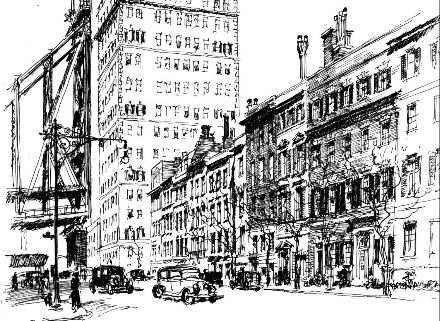
This afternoon, Miss Breed and I were sitting in the Common Room at Canmore attempting to study for our Art and Piety exam on Tuesday and would you know, the young lady has never even heard of Sutton Place nor Beekman Place? Sometimes I think if she hadn’t gone to Brearley and then St Andrews she’d never’ve left Soho. And that would be a tragedy. What is this world coming to?
Meanwhile Mr. Brenner inquires as to why I stated my preference for Murray Hill among the neighborhoods of Manhattan. It is somewhat on the quieter side of things, it has one of the best parishes in the Archdiocese (the Church of Our Saviour) and is within walking distance of another (my beloved St. Agnes), is home to the Union League Club, the English-Speaking Union, and other institutions, and the general tendency of the architecture is fairly attractive. Why not?
Alright, there are plenty of desirable districts in Manhattan. Sutton Place/Beekman Place, Carnegie Hill, Yorkville, Riverside Drive, some parts of Greenwich Village, and up top Hudson Heights and the Fort Tryon Park area aren’t bad. Depending on the accomodation, I’d be happy to live in any of those areas; especially one of those wonderful nostalgic neo-Dutch buildings on the West Side, or something neo-Georgian on the East Side.
Anyhow, for the edification of Miss Breed, here are the B&TC on Sutton Place, and the City Review as well.
Which Way Forward for the Sun?
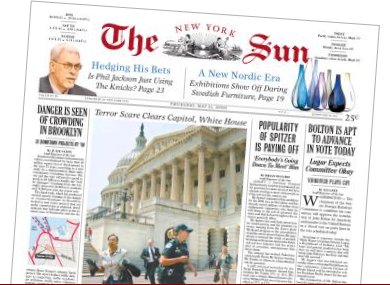
Marty Browne, a loyal reader from Queens, has brought to my attention that a hooplah has taken place in a few media outlets recently concerning our beloved New York Sun. Essentially, two memos written by Robert Messenger, deputy managing editor of the Sun, were somehow leaked to Gawker, Gotham’s flitty rumor mill, and posted on May 11, 2005.
 The two memos deal with the state of the Sun at the moment and highlights some concerns over its long-term future, suggesting something of a ‘back to basics’ course for the three-year old conservative broadsheet. Our friend Mr. Browne was concerned enough to write a letter to the editor cautioning against changing our beloved Sun, bar adding a few more voices from the old right (advice which should be heeded). But having read the memo, I think it offers a frank analysis of the paper today and productive suggestions for the direction it should go in.
The two memos deal with the state of the Sun at the moment and highlights some concerns over its long-term future, suggesting something of a ‘back to basics’ course for the three-year old conservative broadsheet. Our friend Mr. Browne was concerned enough to write a letter to the editor cautioning against changing our beloved Sun, bar adding a few more voices from the old right (advice which should be heeded). But having read the memo, I think it offers a frank analysis of the paper today and productive suggestions for the direction it should go in.
Essentially, what the Sun has to do is decide what it will be. It would be excellent if New York could have a general interest conservative broadsheet newspaper. However, given the overwhelmingly liberal market, I doubt the city’s ability to support such an endeavour; a luxury we sadly cannot afford.
In the mad media market of Manhattan, the most reliable option for the Sun is not as a general interest paper, a more financially-precarious model, but instead to find a niche in which to solidly rest. The weekly New York Observer, only born in the nineties, has a niche which gives it a fairly firm foundation provided it continues to serve it well, and the Sun should take note of that.
Thus the niche market is the way to go. What niche though? In my opinion, the New York Sun should be three things: 1) Conservative, 2) High-brow, 3) Metropolitan.
1) The Conservative Newspaper: The right-minded mustn’t just give up and concede New York as legitimately 100% liberal. This simply would not reflect reality, and the Sun must continue to provide a conservative voice on a higher scale than the populist New York Post.
2) The High-Brow Newspaper: Arts & Letters is already the most flourishing section and long may it continue. James Gardner on great on Architecture and I am absolutely loyal to the architectural historian Francis Morrone’s ‘Abroad in New York’ column every Monday. The Editorial and Opinion sections provide good sound argument and discussion, but could do with expansion.
3) The Metropolitan Newspaper: Of course it must continue to be an intrinsically New York paper. Coverage of the civic, political, and social sides of the city are essentially. This department has been pretty solid and consistent, and should only be augmented.
Should the New York Sun aim to be the conservative, high-brow, metropolitan newspaper, I believe it will be a winning formula, and set the newspaper well along on path towards becoming a great New York institution, if it isn’t one already.
(Continue reading for my thoughts on a few of Mr. Messenger’s points.)
New Washington Square Plans

The Parks Department have unveiled their plans for the renvoation of Washington Square Park. I thouroughly approve. The main point is the replacement of the fountain with one along the axis of the Arch. This is a great improvement. The current layout of the Square is from when the road arrangement allowed you to drive through it, through the Arch in fact. When the Square was completely pedestrianised, they merely redirected and turned the former roads into paths, without any general rethink of the Square’s arrangement. The new plan orients the park around the Arch’s axis, which terminates on the N.Y.U. Catholic Church on Washington Square South. Unfortunately, the Church is a grievous 1970’s monstrosity ripe for being torn down and replaced by some of the bright gang from Notre Dame. (more…)
Search
Instagram: @andcusack
Click here for my Instagram photos.Most Recent Posts
- Amsterdam November 26, 2024
- Silver Jubilee November 21, 2024
- Articles of Note: 11 November 2024 November 11, 2024
- Why do you read? November 5, 2024
- India November 4, 2024
Most Recent Comments
- on The Catholic Apostolic Church, Edinburgh
- on Articles of Note: 11 November 2024
- on Articles of Note: 11 November 2024
- on Why do you read?
- on Why do you read?
- on University Nicknames in South Africa
- on The Situation at St Andrews
- on An Aldermanian Skyscraper
- on Equality
- on Rough Notes of Kinderhook
Book Wishlist
Monthly Archives
Categories


